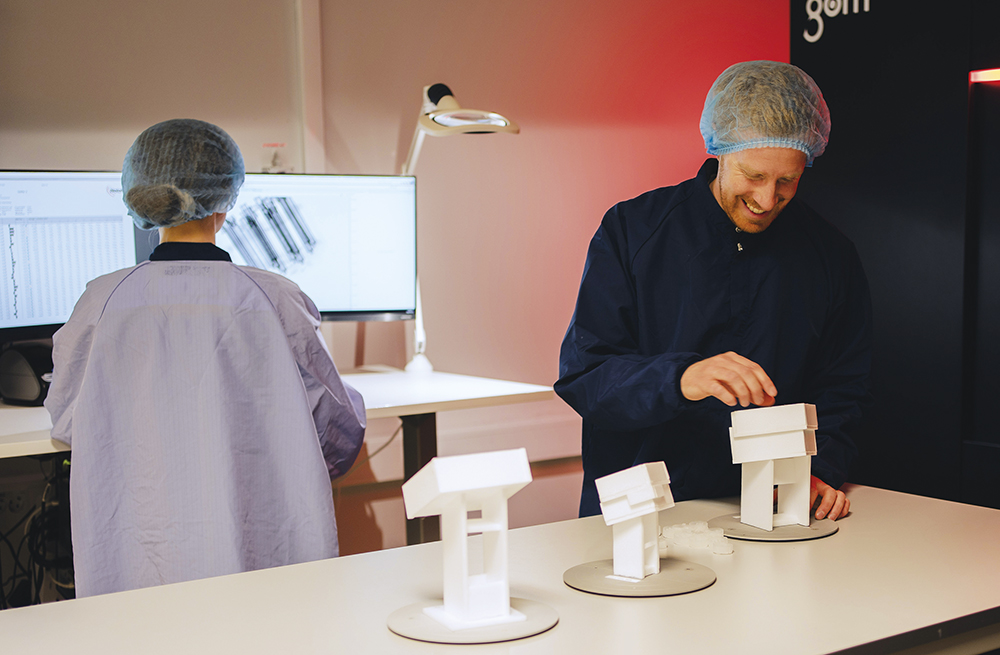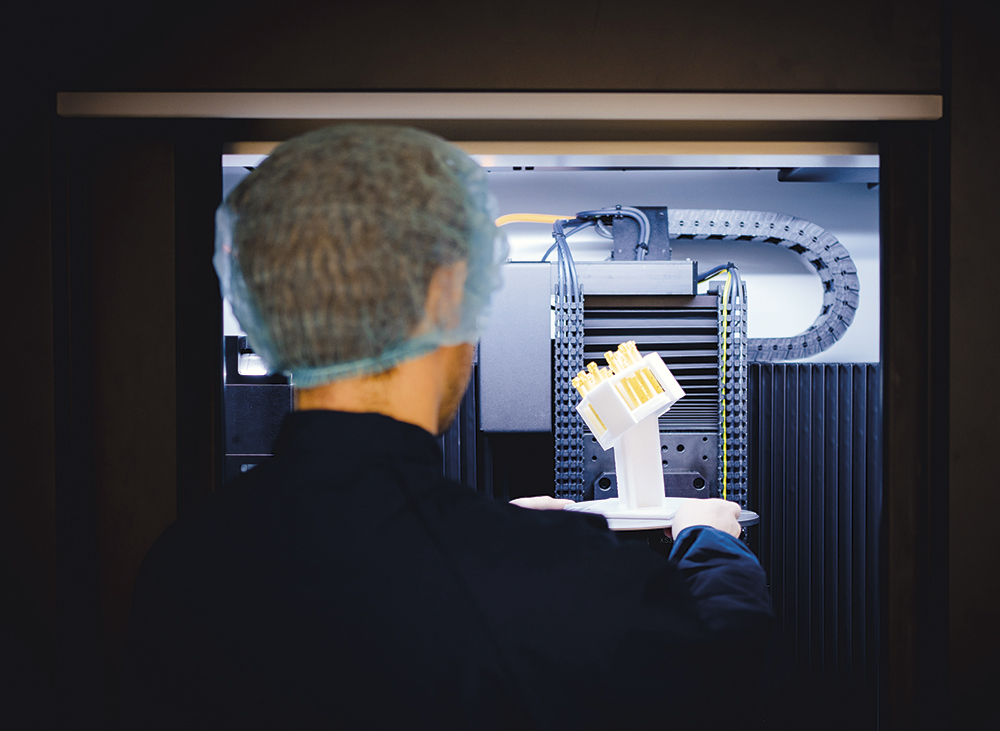Citation: Ingvarsson P, “Nolato’s Virtual Factory in Action: Accelerating Drug Delivery Innovation”. ONdrugDelivery, Issue 178 (Oct 2025), pp 114–116.
Patrik Ingvarsson discusses Nolato’s virtual factory methodology, wherein embedded technical experts help drug delivery device developers reduce risk, costs and time to market through intelligent application of simulations to facilitate smoother and more robust development cycles with fewer iterations required.
DELIVERING RELIABLE DEVICES FASTER
In the development of complex drug delivery devices, achieving a combination of innovation, quality and speed to market is increasingly critical. Whether it is an autoinjector, pen injector or prefilled syringe, pharmaceutical companies are looking for more effective ways to manage risk, reduce costs and ensure robust manufacturing from the outset.
Nolato addresses this challenge through its virtual factory methodology, designed to improve and de-risk the product development journey. By combining simulation-driven design with manufacturing expertise and global scalability, Nolato offers a structured path from concept to commercial high-volume production.
This front-loaded, simulation-first approach is driven by the company’s technical design centres (TDCs), which operate as embedded partners within customer development teams. From concept to industrialisation, Nolato provides digital tools, manufacturing insights and design support to help bring safe and reliable products to market more quickly and with fewer iterations than conventional methods. This proactive involvement enables a more stable and transparent development process, ultimately improving both predictability and performance.
EMBEDDED ENGINEERING: CLOSING THE GAP BETWEEN DESIGN AND PRODUCTION
Rather than acting as an external consultant, Nolato embeds its engineers into its customers’ teams from day one. These engineers support real-time design for manufacturing decisions, reducing late-stage changes and streamlining the transfer to production.
“BY WORKING SIDE BY SIDE WITH CUSTOMER TEAMS, EMBEDDED ENGINEERS CAN GAIN DEEP CONTEXTUAL UNDERSTANDING THAT CAN BE CRUCIAL IN FAST-PACED DEVELOPMENT ENVIRONMENTS.”
This collaborative model enables early alignment on key design features, supports sustainable and cost-efficient solutions, and reduces the risk of misalignment later in the process. Integrating mould flow simulation, tolerance analysis and virtual metrology from the start helps prevent downstream issues and supports faster decision making. By working side by side with customer teams, embedded engineers can gain deep contextual understanding that can be crucial in fast-paced development environments.
VIRTUAL FACTORY IN ACTION
In a recent project involving a multi-component drug delivery device, Nolato worked with a customer on 14 precision-moulded plastic components. The TDC team was fully integrated into the customer’s development process, using virtual factory tools at every stage.
Using Moldex3D (CoreTech System Co, Zhubei City, Taiwan) for mould flow analysis and Zeiss Inspect (Zeiss, Oberkochen, Germany) for computed tomography (CT)-based metrology simulation (Figure 1), Nolato virtually analysed over 440 individual dimensions. This enabled the team to anticipate measurement outcomes and define a robust measurement strategy before pilot tools had been ordered. When physical parts were produced, all dimensions were within tolerance, with only four needing slight adjustments to approach the nominal target more closely. This was achieved without having an impact on the development timeline.

Figure 1: Nolato’s virtual factory incorporates CT-based simulations as part of its toolset.
According to the customer, the project ran “easy and smooth”, with specific praise for Nolato’s simulation expertise and dimensional assurance. This outcome was achieved through early validation and data-driven decision making embedded in the development model. It reflects how systematic simulations and planning can replace costly iterations and uncertainty.
VIRTUAL PROTOTYPING AND DIMENSIONAL VALIDATION
The virtual factory methodology starts with simulation of component behaviour using a combination of:
- Mould flow analysis for evaluating material flow, cooling behaviour and warpage
- Tolerance stack-up simulations to ensure assembly fit and identify critical dimensions
- Finite element analysis for validating stress performance and structural reliability
- Virtual dimensional measurement planning for pre-validating inspection strategies
- CT scanning evaluation software for simulating and analysing measurement results.
“THIS APPROACH ENSURES CONSISTENCY BETWEEN VIRTUAL VALIDATION AND PHYSICAL QUALIFICATION AND ENABLES
FASTER CORRELATION BETWEEN PREDICTED AND ACTUAL OUTCOMES.”
Measurement programs are developed early using CT-based evaluation tools, simulating the inspection process as it will be carried out on physical parts (Figure 2). These programs are tested and verified in the virtual environment, allowing teams to apply the same measurement strategies to both simulation data and real-world samples. This approach ensures consistency between virtual validation and physical qualification and enables faster correlation between predicted and actual outcomes.

Figure 2: CT-based tools are used to simulate the inspection process.
These tools support detailed analysis of geometry, manufacturing feasibility and part-to-part fit before physical tools are created. Simulations also enable early identification of potential risks, such as sink marks, air entrapment or misalignment. The resulting metrology plans are then directly applicable when real parts are produced, saving time and reducing trial iterations.
This simulation-first approach ensures that the physical validation phase is faster and more predictable, reducing the time between design freeze and product launch. It also supports better communication between design and manufacturing stakeholders by providing a common reference based on quantifiable simulation results.
SCALABILITY: FROM PILOT TO HIGH-VOLUME MANUFACTURING
A key strength of Nolato’s approach is its ability to scale. Starting from low-volume pilot production, the development path is designed to seamlessly support transfer into fully automated cleanroom manufacturing. This transition is supported by a phase-gated model involving design, tooling, automation and quality experts early in the project. As a result, virtual models evolve into validated processes with fewer surprises during scale-up. This structured collaboration ensures that automation strategies and quality control are already considered well before production reaches full scale.
FLEXIBLE INFRASTRUCTURE TO MATCH PRODUCT NEEDS
Nolato operates 17 certified medical manufacturing facilities worldwide, including ISO 13485-compliant and US FDA-registered sites. This allows its customers to localise production while maintaining high quality standards. Whether scaling a wearable injector or launching a high-volume pen injector, Nolato’s global footprint and local decision making ensure responsiveness and alignment. Its recent expansions in Southeast Asia and Europe demonstrate the company’s readiness to support dynamic project needs. This flexibility can help Nolato’s customers navigate shifting regulatory environments and respond to market demand without compromising delivery timelines or quality.
FRONT-LOADED DEVELOPMENT FOR PREDICTABLE OUTCOMES
Nolato’s virtual factory is not just a toolkit but a comprehensive methodology that connects simulation, measurement and manufacturing right from the start of product development. By embedding engineering expertise early and validating key performance indicators before steel is cut, Nolato helps development teams reduce uncertainty and accelerate delivery.
This model supports faster decision making, fewer tool iterations and more predictable manufacturing outcomes, resulting in more reliable product launches for demanding drug delivery devices. In a landscape where timelines are tight and compliance is non-negotiable, this kind of early integration provides a crucial advantage.

